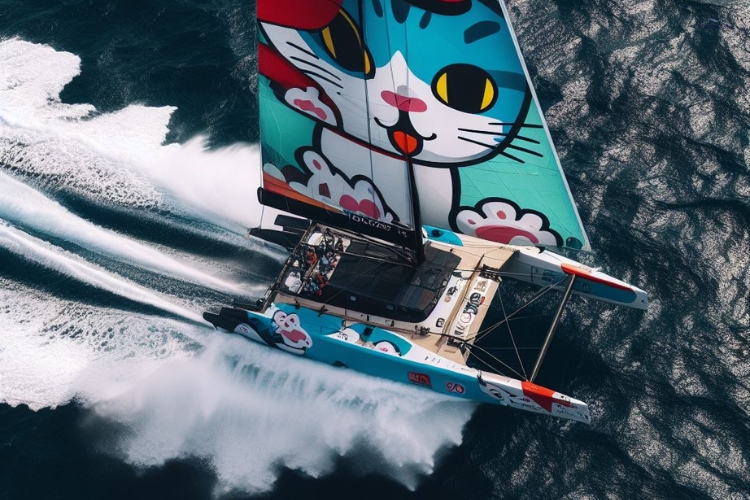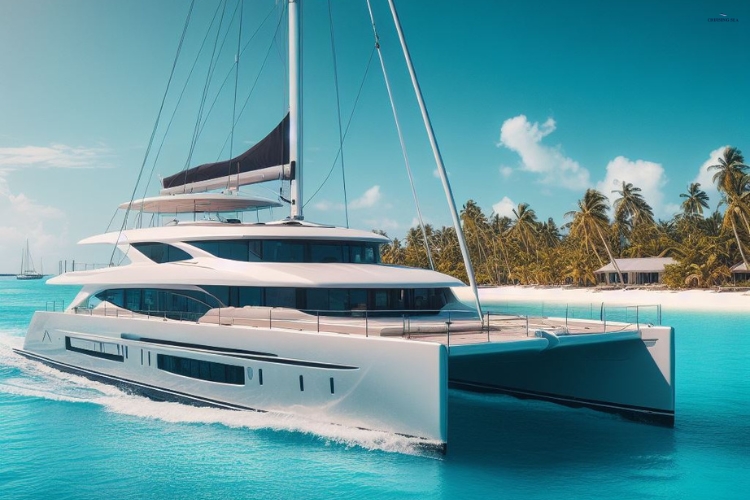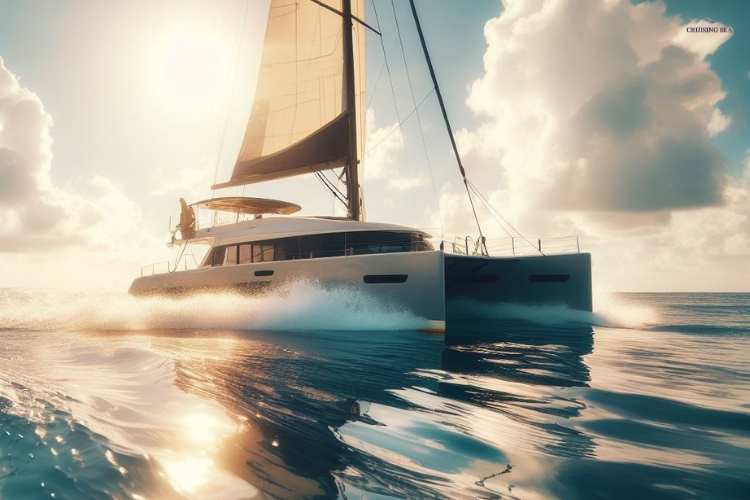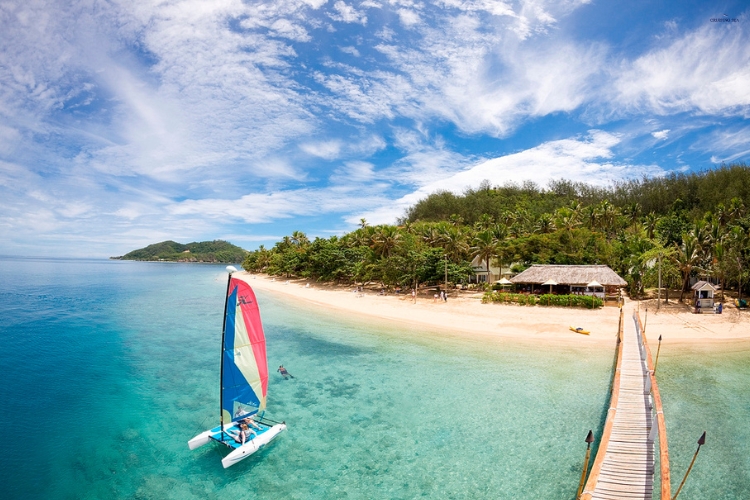Catamarans are known for their speed and stability, making them popular choices for both racing and cruising. However, many sailors wonder why can’t catamarans sail close to the wind.
To understand this peculiar behavior, it’s essential to examine the design factors and sailing techniques used with these unique vessels.
The primary reason catamarans have difficulty sailing upwind is their lack of a keel and shallow draft, which affects their stability and overall efficiency.
Additionally, other design features such as lateral resistance, apparent wind generation, and sheeting angle further contribute to this challenge. However, with the right knowledge and techniques, catamaran sailors can still navigate close to the wind successfully.
Key Takeaways
- Some catamarans struggle to sail close to the wind due to several design factors.
- Lack of a keel and shallow draft contribute to reduced upwind efficiency
- Advanced techniques can help catamaran sailors navigate close to the wind successfully
Do All Catamarans Sail The Same Way?
Production catamarans come in a wide range of configurations, from spacious cruising models to high-performance racers. People often wonder, do all catamarans sail the same way? Let’s delve into the topic, focusing on production sailing catamarans.
Production Sailing Catamarans: Comfort vs Performance
Some do, and some don’t focus on production sailing catamarans for comfort versus performance. All vessels, including your catamaran, are designed for a particular mission. Some catamarans prioritize high-performance sailing, while others focus on comfort, load-carrying ability, and sailing in rougher weather.
Cruising vs Racing Catamarans:
Your widely marketed cruising catamaran is designed with massive interior space, living areas, and wide hulls, allowing walk-around berths and keeping the deck very level on most points of sailing for your comfort, even when heeled at an angle that others may find unpleasant.
In contrast, the high-performance boat you are considering has daggerboards that, like on most mono-hulls, greatly reduce sideways slipping to adjust performance and allow anchoring in shallow water.
These boats have very narrow hulls, providing far less resistance through the water, allowing you to sail closer to the wind and at higher speeds.
High-performance Catamaran

Cruising Catamaran

Cruising Catamaran Keels:
The stub keels on most cruising catamarans do not require constant adjusting of daggerboard depth for different points of sailing or boat speed and allow your catamaran to sit on the beach or land without support. They require less maintenance than daggerboards but provide less sailing performance than a high-performance design.
Sailing Performance:
Each designer has optimized each catamaran model for a specific market segment focused on either comfort, speed, or compromise. You can choose the design that best matches your priorities. Catamarans generally sail faster when sailed at angles over 60-70 degrees away from the wind, but many cannot match the close-hauled performance of specialized racing monohulls and performance catamarans. You must research each design to understand its windward capabilities.
Sailing Instruments:
Modern sailing instruments on your catamaran can display both true wind speed and angle, as well as apparent wind speed, accounting for the boat’s motion. This allows you to optimize your sail trim for maximum velocity made good toward your destination under different conditions.
Comparing Monohulls and Catamarans:
While many monohulls sail better windward than cruising catamarans, high-performance cats can match specialized racing monos in a blow. You must consider your priorities, like interior space versus top-end speed, when choosing between monohull and catamaran designs. Research each model to get the right fit for your sailing style and needs.
Why Catamarans Struggle To Sail Close to the Wind?

Now, let’s explore the challenges faced by catamarans when it comes to sailing close to the wind. We’ll focus on understanding the wind and sailing, as well as the specific aspects of sailing a catamaran upwind.
Understanding the Wind and Sailing
Sailing is an art as well as a science, and one of the key elements of successful sailing is harnessing the power of the wind. When you’re sailing, it’s crucial to understand the concept of the “no-go zone,” where your boat cannot sail directly upwind.
The closer you can get to this zone, known as sailing “close-hauled,” the better you can take advantage of the wind’s power.
When sailing close-hauled, your sail’s leading edge (the luff) is facing into the wind, while the trailing edge (the leech) is pulled tight.
Telltales (small pieces of yarn or ribbon attached to your sail) can help you determine whether you’re sailing close to the wind, as they should flow directly to the leech, parallel to the wind.
The Aspects of Sailing a Catamaran Upwind
When it comes to catamarans, sailing close to the wind can be more challenging than on monohulls. Here are some reasons why:
- Wide Beam: Catamarans have a wider beam than monohulls, which means they have more wind resistance and are less streamlined when sailing upwind.
- Daggerboards: Many catamarans lack full daggerboards, which help counterbalance the sail force of the wind. Without them, catamarans struggle to point upwind as efficiently as monohulls.
- Mast Rigging: Catamarans often have more difficulty achieving a tight sail luff due to their mast rigging configuration. To enhance upwind performance, some custom-built catamarans opt for expensive carbon fiber masts and high-tech shrouds that are lighter and stiffer.
- Pitching Moment: Catamarans have a strong pitching moment because of their wide and light design, making it difficult for them to sail efficiently upwind.
The Design Features of Catamarans Impacting Sailing
Comparison with Monohull Boats
When you see a catamaran, you’ll notice that it has two hulls, unlike the single hull of a monohull boat. This design offers more stability and space, but it also impacts the way catamarans sail.
For example, catamarans lack a keel, which means they don’t have the same stability as monohulls when it comes to sailing upwind.
One of the key differences between a catamaran and a monohull is the way they harness the wind to generate lift. Monohulls rely on heeling and the shape of their hull to create lift, while catamarans mostly use their sails, daggerboards, and the angle of the wind to achieve this.
The shape of a catamaran’s hulls also leads to less lateral resistance, making them less efficient at sailing upwind.
Effect of Weight and Comfort Features on Speed
As mentioned above, cruising Catamarans are known for their comfort and space, but these characteristics can impact their performance. The increased beam and more generous living spaces can contribute to additional weight, which affects the boat’s overall speed and ability to sail upwind.
Some catamarans also have wetted surface areas that are significantly larger than those of monohulls, leading to higher drag and reducing their upwind efficiency.
To improve upwind sailing performance, catamarans often incorporate daggerboards and/or jib, which help create lift and resist lateral movement. Daggerboards can be raised and lowered, depending on the sailing conditions, to maximize lift and reduce drag.
The use of a well-designed mainsail, boom, and rudder can also enhance a catamaran’s ability to sail closer to the wind.
Despite these design elements, you might have to adjust your sailing strategy when aboard a catamaran.
Instead of attempting to sail as close to the wind as possible, you can bear off a few degrees to build up apparent wind and power your sails, which allows the rig to generate more forward drive.
Advanced Techniques for Sailing Catamarans Close to the Wind
Optimizing Daggerboard Use
To improve your catamaran’s upwind performance, the correct use of daggerboards is essential. Daggerboards help reduce leeway, increasing your yacht’s pointing ability.
When sailing close to the wind, lower the windward daggerboard fully and raise the leeward one to about half. This configuration enhances the catamaran’s maneuverability and reduces drag, allowing you to sail at a closer angle to the wind.
Adapting to Weather Conditions
Weather conditions play a significant role in how well a catamaran can sail upwind. In lighter conditions, it’s essential to keep your boat moving by minimizing tacking maneuvers, which tend to slow down a catamaran compared to monohulls.
When the wind picks up, be prepared to reef sails and adjust your course accordingly. If stormy weather approaches, prioritize maintaining control and achieving a moderate speed without endangering the boat or the crew.
Navigational Aids and Their Role
To sail a catamaran close to the wind efficiently, it’s helpful to take advantage of navigational aids such as a chart plotter and autopilot.
A chart plotter allows you to plan your course while the autopilot keeps you on track, giving you time to focus on sail trim, daggerboard use, and other factors.
Also, sailing upwind requires constant attention to wind shifts; using instruments like wind indicators and GPS can help you to identify and react to changes in wind conditions.
Frequently Asked Questions
Q: How do catamarans perform in upwind sailing?
Catamarans typically face challenges when sailing upwind. The design with two hulls and a shallow draft makes them less efficient at sailing close to the wind compared to monohulls. Catamarans usually sail at an angle of 35 to 50 degrees off the wind.
Q: What factors affect a catamaran’s ability to sail close to the wind?
Several factors can influence how close to the wind a catamaran can sail:
- Hull shape: The shape and underwater profile of the catamaran’s hulls will impact its upwind performance.
- Windage: Catamarans have a wider beam and more surface area, which increases the amount of wind resistance they face.
- Lateral resistance: A catamaran’s underwater surface area affects its lateral resistance, making it more difficult to sail upwind in some conditions. Decreased lateral resistance in the water can cause the boat to be less efficient upwind.
Q: What are some techniques to improve upwind sailing on a catamaran?
There are several techniques you can use to improve upwind sailing on a catamaran:
- Optimize sail trim: Properly trimming your sails can make your catamaran more efficient upwind.
- Reduce windage: Minimizing the amount of gear and equipment stored on deck can lower the wind resistance.
- Choose the right sails: Using the appropriate sails for the specific wind conditions can improve performance.
Q: How does sail shape influence catamaran performance in the wind?
The shape and size of sails play a crucial role in how efficiently a catamaran can sail in the wind. When sailing upwind, a flatter sail shape is more effective as it creates less drag and generates better airflow. In contrast, a fuller sail shape is better for sailing downwind and reaching.
Q: Are there any modifications to enhance the upwind capabilities of a catamaran?
Yes, there are modifications that can enhance a catamaran’s upwind performance:
- Adding daggerboards or centerboards: These additions can provide more lateral resistance, improving the catamaran’s ability to point higher into the wind.
- Installing high-aspect ratio sails: These sails are taller and narrower, providing better lift and less drag upwind.
- Upgrading your rigging: Higher-quality rigging components can allow for improved sail shape adjustments, optimizing your catamaran’s upwind performance.
Q: How do power catamarans perform compared to sailing catamarans in terms of wind angles?
Power catamarans are not as affected by wind angles compared to sailing catamarans because they rely on engine power rather than sails. They generally have better control and maneuverability in the wind. However, they may still experience increased wind resistance due to their wide beam and larger surface area.
Final Words!
In conclusion, while catamarans are renowned for their speed and stability, they do face limitations when it comes to sailing close to the wind. The reasons stated in the article.
However, it’s important to note that catamarans excel in many other aspects of sailing, such as reaching and running with the wind, where their broad hulls provide excellent stability and speed.
Sailors and designers have continually innovated to overcome these limitations, exploring different techniques and technologies to enhance catamarans’ upwind performance.
So, while catamarans may struggle to sail as close to the wind as some other types of boats, their overall advantages in terms of speed, stability, and spaciousness make them a popular choice among sailors worldwide.
Want More Tips?
Subscribe to Cruising Sea newsletter to receive every two-week the latest post straight to your inbox

Daniella has been passionate about travel, the sea, and nature for many years. As a child, she frequently traveled throughout the Mediterranean and continued with her journeys throughout her adult life.
Her experiences have created the desire within her to share her love for traveling with other passionate and adventurers who want to discover beautiful horizons and new cultures.


Great article on the challenges catamarans face when sailing close to the wind! The explanations regarding hull shape, windage, and lateral resistance were very informative. I have a question for you: Are there any specific catamaran models or designs that have successfully addressed these challenges and perform exceptionally well when sailing upwind, and if so, what sets them apart? Thanks for sharing your insights!
Hi Hanna,
Thanks for the feedback. I’m glad you found the article informative. There are definitely some catamaran designs that do pretty well upwind compared to traditional models. A few that stand out are the Farrier F-22, Lagoon 450, and Outremer 5X. What sets them apart is their narrower hulls and more pronounced bow sections, which allow them to punch through waves more easily when sailing closer to the wind. The sail plans on these designs also tend to be optimized for upwind performance with larger headsails and overlapping genoas. Some even have movable ballast or hydrofoils that help reduce leeway in strong winds. Of course, no cat will point as high as a monohull, but these models seem to do the best job minimizing the inherent lateral resistance that cats face when sailing close-hauled. Let me know if you have any other questions, I’ll be more than happy to answer:)
Thank you again for the comment and I wish you a lovely day.
The article provides a compelling overview of why catamarans face challenges sailing close to the wind. It’s particularly interesting to consider the trade-offs between comfort and performance in production catamarans. However, one question remains: How significant is the difference in upwind performance between a high-performance catamaran with daggerboards and a similarly sized monohull designed for racing? Could you elaborate on the specific design elements that contribute to this performance gap?
Hi Andrew,
Thank you for your comment. I am glad you found the article useful!
When you compare the upwind performance of a high-performance catamaran with daggerboards to a racing monohull, you’ll notice distinct differences due to their design elements. Your catamaran’s daggerboards provide lift and reduce sideways slippage, allowing for higher speeds even if it doesn’t point as close to the wind as the monohull. The catamaran’s dual, slender hulls also decrease drag, contributing to its speed advantage.
In contrast, your monohull relies on a deep keel with a weighted bulb for stability and upwind efficiency, allowing it to sail closer to the wind but typically at a slower speed than a catamaran. The monohull’s ability to heel reduces the wetted surface area, which helps its upwind performance.
Overall, the catamaran’s speed may compensate for its lower pointing ability, while the monohull prioritizes a closer wind angle over speed. Design elements like hull shape, keel or daggerboard design, and weight distribution play crucial roles in defining each vessel’s upwind capabilities.
I hope it helped. If you need more information, let me know. I am always happy to assist.